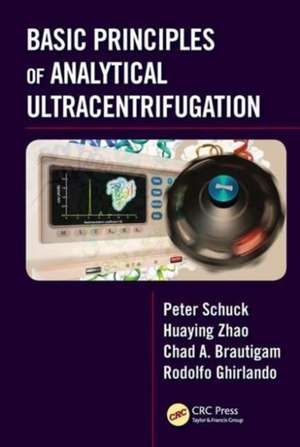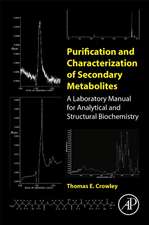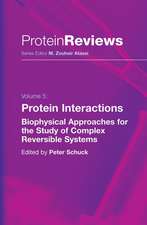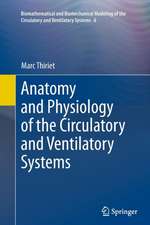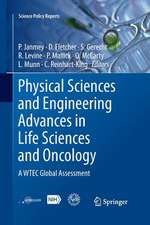Basic Principles of Analytical Ultracentrifugation
Autor Peter Schuck, Huaying Zhao, Chad A. Brautigam, Rodolfo Ghirlandoen Limba Engleză Hardback – 18 dec 2015
Filling this gap in the literature of biophysical methodology, Basic Principles of Analytical Ultracentrifugation explains the fundamentals in the theory and practice of AUC. The book provides you with up-to-date experimental information to confidently practice AUC. You will understand the basic concepts, full potential, and possible pitfalls of AUC as well as appreciate the current relevance of past work in the field.
The book first introduces the basic principles and technical setup of an AUC experiment and briefly describes the optical systems used for detection. It then explores the ultracentrifugation experiment from a macromolecular standpoint, offering a detailed physical picture of the sedimentation process and relevant macromolecular parameters. The authors present important practical aspects for conducting an experiment, including sample preparation, data acquisition and data structure, and the execution of the centrifugal experiment. They also cover instrument calibration and quality control experiments.
| Toate formatele și edițiile | Preț | Express |
|---|---|---|
| Paperback (1) | 421.82 lei 6-8 săpt. | |
| CRC Press – 30 iun 2020 | 421.82 lei 6-8 săpt. | |
| Hardback (1) | 718.91 lei 6-8 săpt. | |
| CRC Press – 18 dec 2015 | 718.91 lei 6-8 săpt. |
Preț: 718.91 lei
Preț vechi: 876.73 lei
-18% Nou
Puncte Express: 1078
Preț estimativ în valută:
137.58€ • 149.39$ • 115.57£
137.58€ • 149.39$ • 115.57£
Carte tipărită la comandă
Livrare economică 22 aprilie-06 mai
Preluare comenzi: 021 569.72.76
Specificații
ISBN-13: 9781498751155
ISBN-10: 1498751156
Pagini: 324
Ilustrații: 62 black & white illustrations, 22 colour illustrations, 13 black & white tables
Dimensiuni: 178 x 254 x 23 mm
Greutate: 0.98 kg
Ediția:1
Editura: CRC Press
Colecția CRC Press
ISBN-10: 1498751156
Pagini: 324
Ilustrații: 62 black & white illustrations, 22 colour illustrations, 13 black & white tables
Dimensiuni: 178 x 254 x 23 mm
Greutate: 0.98 kg
Ediția:1
Editura: CRC Press
Colecția CRC Press
Cuprins
Analytical Ultracentrifugation Basics. The Sedimenting Particle. Sample Preparation and Ancillary Characterization. Data Acquisition. The Sedimentation Experiment. Control and Calibration Experiments. Appendices.
Notă biografică
Peter Schuck is an Earl Stadtman Tenure‐Track Investigator and Chief of the Dynamics of Macromolecular Assembly Section in the Laboratory of Cellular Imaging and Macromolecular Biophysics at the National Institute of Biomedical Imaging and Bioengineering, U.S. National Institutes of Health. He obtained his Ph.D. from the Goethe‐University Frankfurt am Main, where he worked on interactions of integral proteins of the erythrocyte membrane using analytical ultracentrifugation.
Huaying Zhao is a Staff Scientist in the Dynamics of Macromolecular Assembly Section in the Laboratory of Cellular Imaging and Macromolecular Biophysics at the National Institute of Biomedical Imaging and Bioengineering, U.S. National Institutes of Health. She received a Ph.D. in chemistry from the University of Mississippi, with a specialization in protein biochemistry. Her main research interests are the development of biophysical methodology for characterizing a variety of macromolecules, including proteins, nucleic acids, polymers, and nanoparticles.
Chad A. Brautigam is an Associate Professor in the Department of Biophysics at The University of Texas Southwestern Medical Center. He earned a Ph.D. in biophysics from Yale University. His research focuses on the structures and functions of lipoproteins of pathogenic bacteria. He is also interested in improving the analysis and presentation of biophysical data.
Rodolfo Ghirlando is a Staff Scientist in the Laboratory of Molecular Biology at the National Institute of Diabetes and Digestive and Kidney Diseases, U.S. National Institutes of Health. He earned his Ph.D. from the Weizmann Institute of Science. His research interests include the study of the in vivo chromatin structure at the 30‐nm fiber level and, more generally, the development of hydrodynamic methodology for the study of challenging biomacromolecular interactions.
Huaying Zhao is a Staff Scientist in the Dynamics of Macromolecular Assembly Section in the Laboratory of Cellular Imaging and Macromolecular Biophysics at the National Institute of Biomedical Imaging and Bioengineering, U.S. National Institutes of Health. She received a Ph.D. in chemistry from the University of Mississippi, with a specialization in protein biochemistry. Her main research interests are the development of biophysical methodology for characterizing a variety of macromolecules, including proteins, nucleic acids, polymers, and nanoparticles.
Chad A. Brautigam is an Associate Professor in the Department of Biophysics at The University of Texas Southwestern Medical Center. He earned a Ph.D. in biophysics from Yale University. His research focuses on the structures and functions of lipoproteins of pathogenic bacteria. He is also interested in improving the analysis and presentation of biophysical data.
Rodolfo Ghirlando is a Staff Scientist in the Laboratory of Molecular Biology at the National Institute of Diabetes and Digestive and Kidney Diseases, U.S. National Institutes of Health. He earned his Ph.D. from the Weizmann Institute of Science. His research interests include the study of the in vivo chromatin structure at the 30‐nm fiber level and, more generally, the development of hydrodynamic methodology for the study of challenging biomacromolecular interactions.
Recenzii
"This state-of-the-art book is very well written and timely. It will be valuable to both experienced and new practitioners in the use of the analytical ultracentrifuge."
—Geoff Howlett, The University of Melbourne
"This eminently readable book tells the outcome — to present date — of a journey of scientific discovery … Sedimentation analysis of macromolecular systems is the field in which Dr. Peter Schuck and his fellow investigators have been involved throughout the present century and to which they have made contributions not only through their own laboratories’ investigations, but through the widespread use of their algorithms and programs by scientists throughout the world. … this book will be as vital a tool for novices as for senior workers seeking guidance on the more recondite areas of analysis. … If you already know about sedimentation analysis, you will find interest and information alike in its pages. If you are a newcomer to the area, you should take advantage of the opportunity to read a well-written and authoritative account, and become excited by its possibilities."
—From the Foreword by Arthur J. Rowe, Nottingham
—Geoff Howlett, The University of Melbourne
"This eminently readable book tells the outcome — to present date — of a journey of scientific discovery … Sedimentation analysis of macromolecular systems is the field in which Dr. Peter Schuck and his fellow investigators have been involved throughout the present century and to which they have made contributions not only through their own laboratories’ investigations, but through the widespread use of their algorithms and programs by scientists throughout the world. … this book will be as vital a tool for novices as for senior workers seeking guidance on the more recondite areas of analysis. … If you already know about sedimentation analysis, you will find interest and information alike in its pages. If you are a newcomer to the area, you should take advantage of the opportunity to read a well-written and authoritative account, and become excited by its possibilities."
—From the Foreword by Arthur J. Rowe, Nottingham
Descriere
Filling a gap in the literature of biophysical methodology, this book explains the fundamentals in the theory and practice of AUC. It introduces the basic principles and technical setup of an AUC experiment and describes the optical systems used for detection. It explores the ultracentrifugation experiment from a macromolecular standpoint, offering a detailed physical picture of the sedimentation process and relevant macromolecular parameters. The authors present important practical aspects for conducting an experiment and cover instrument calibration and quality control experiments.
